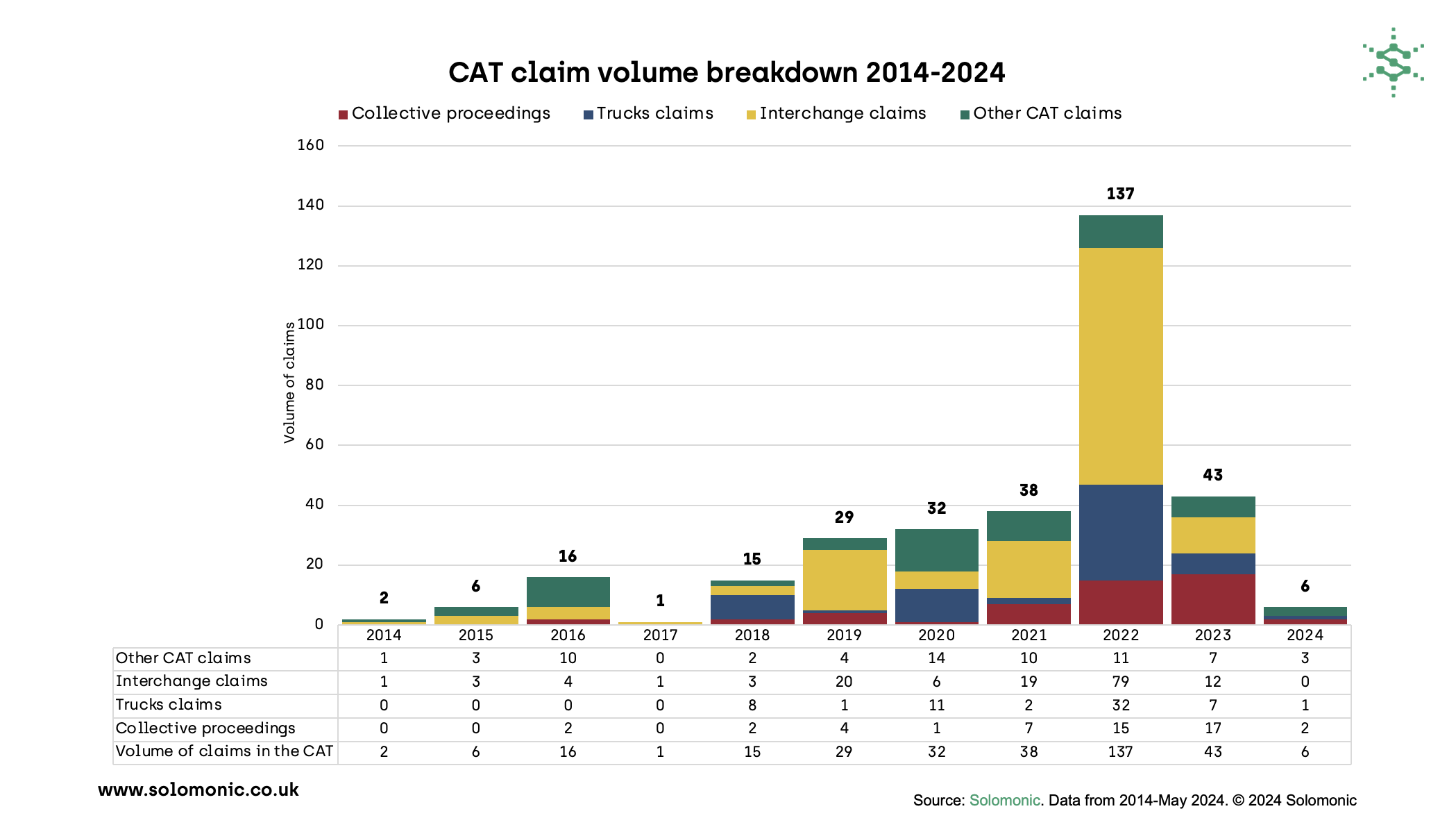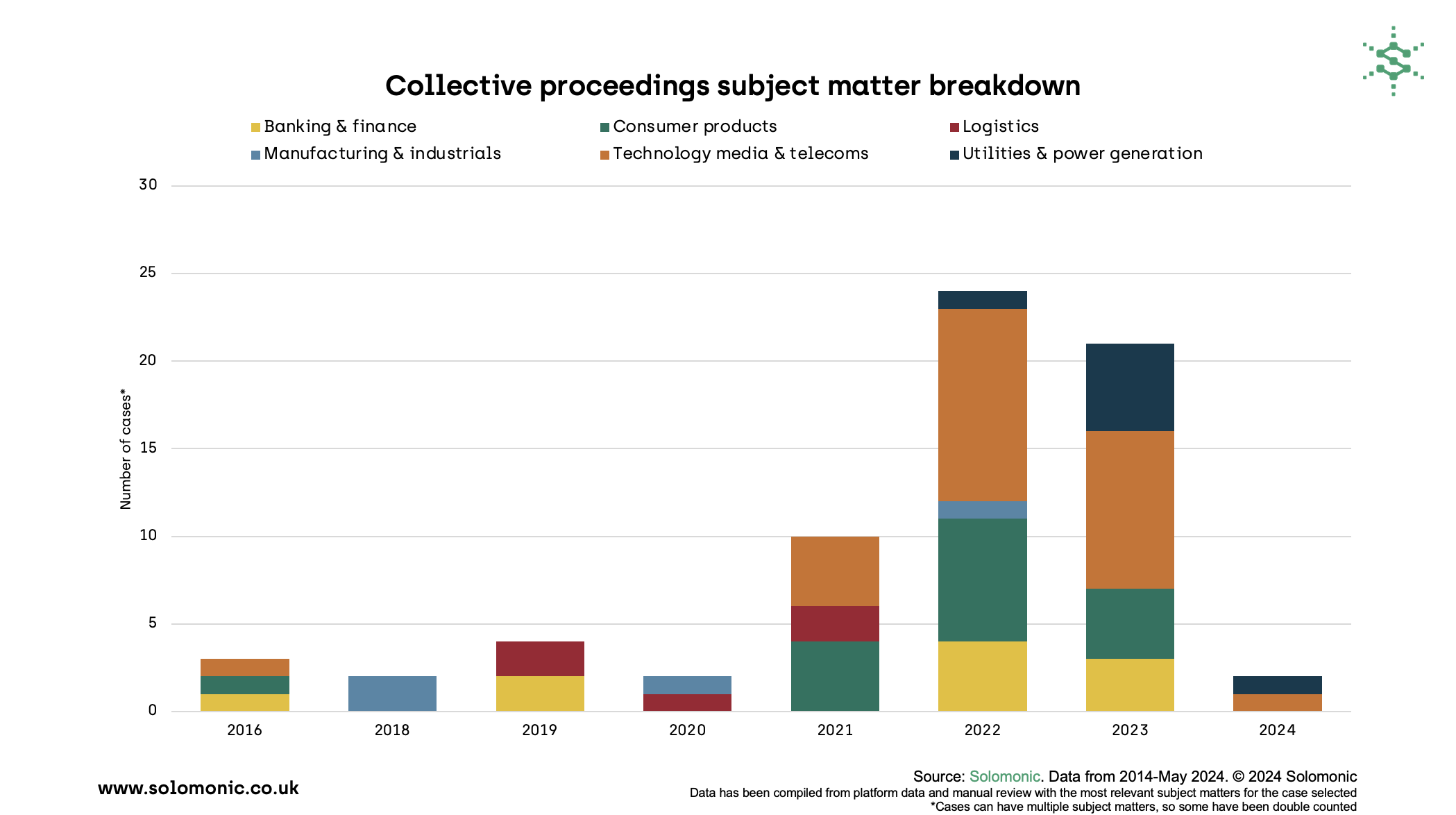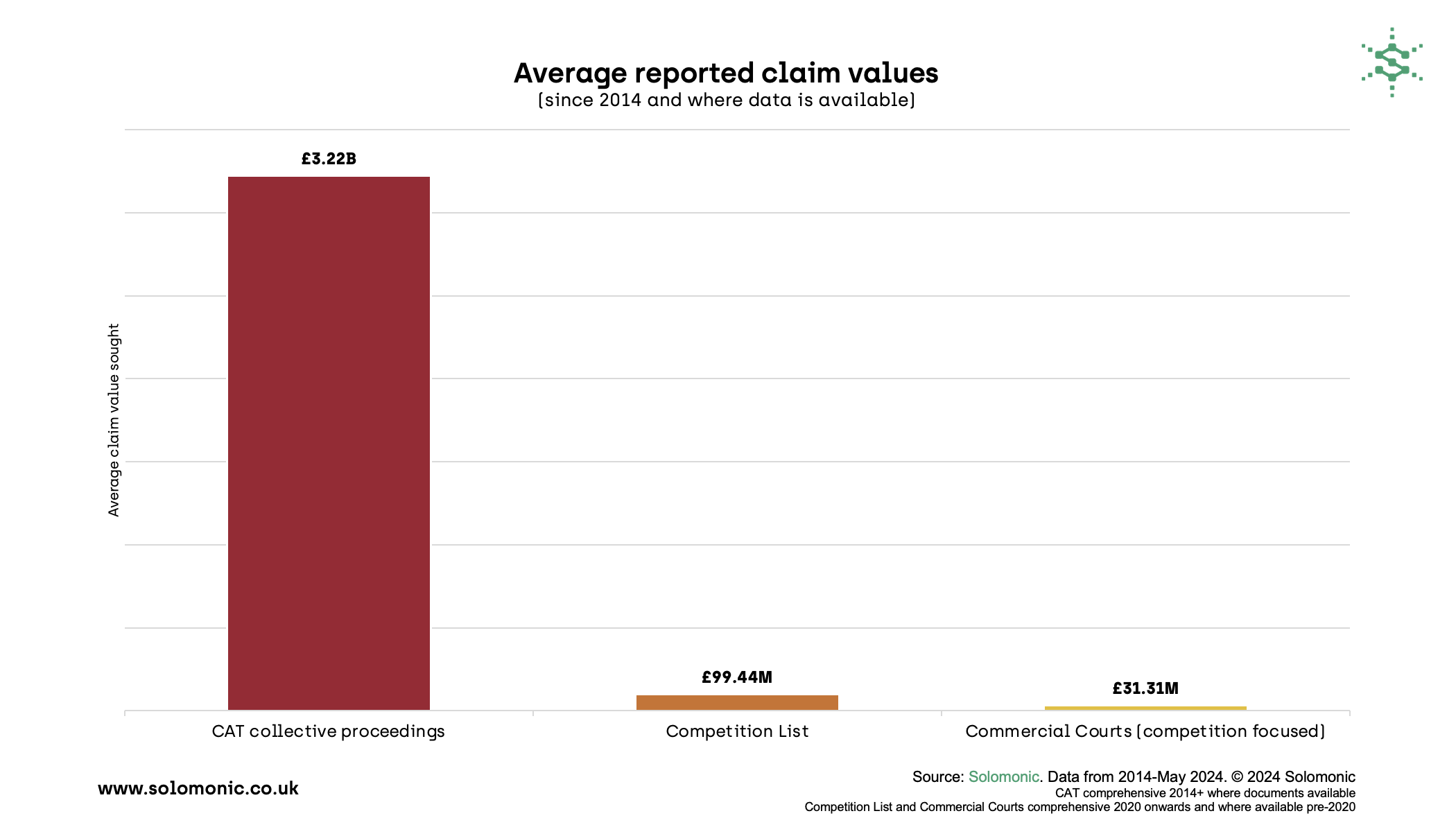CAT amongst the pigeons - Trends in the Competition Appeal Tribunal
Experts in competition litigation from Linklaters, leading competition Chambers Brick Court and reputation consultancy Byfield joined Solomonic to unpack the workings of the Competition Appeal Tribunal (CAT), collective actions and the upcoming trends during Disputes Week 2024.
With the growth of competition collective proceedings in recent years, the Competition Appeal Tribunal (CAT) is transforming itself into the UK’s class actions tribunal. The combination of high value cases (often in the billions), novel legal arguments and the involvement of some of the biggest companies in the world means the growth of the tribunal really has put the cat amongst the pigeons in English commercial litigation. Recognising this, Solomonic called upon leading competition experts to explore the causes and impacts of these trends and the future of litigation in the CAT.
In preparation for the panel discussion, Solomonic and Linklaters worked closely together on an extensive data analysis using Solomonic’s newly launched Competition Module to produce data visualisations that anchored the discussion in rich and objective data.
The panel comprised:
Sarina Williams, Linklaters. Sarina is a partner in the Litigation team at Linklaters and co-head of Linklaters’ global competition litigation practice. She has advised defendants on some of the highest stakes competition litigation in the UK, including interchange, FX, ATMs, power cables and emissions, and is currently advising Visa, Sony and Three in respect of collective actions before the Competition Appeal Tribunal. Sarina was recently named as one of The Lawyer’s “Hot 100” 2024 and she is also chairing the ICC Global Competition Commission’s Task Force for Antitrust Damages Actions.
Robert O’Donoghue KC, Brick Court Chambers. Robert has acted in a number of the major competition and regulatory litigation cases in the UK and internationally. This includes numerous disputes in the High Court and CAT, both in appeals against CMA decisions as well as in follow-on damages claims. He is also active in several of the major ongoing collective actions in the CAT, including Gormsen v Meta, Google Adtech, and Ennis v Apple. He has recently been described by Chambers as “Head and shoulders above his contemporaries, he is a brilliant and outstanding advocate.”
Gus Sellitto, Byfield Reputation Counsel. Gus is a PR industry leader, most particularly in litigation communications and has advised clients on reputational risk and PR strategy across the full range of disputes. He has particular expertise in class action disputes and has worked with third party funders, in-house legal teams and claimants and defendants in national and global disputes. He is also the founding chairman of the PRCA Legal Group and is regularly approached for comment by the national news media on litigation related reputational risk.
Drivers behind the growth of the CAT
Solomonic’s data shows a notable growth in the volume of claims within the Competition Appeal Tribunal (CAT) and a relative decrease in claims in the Competition List and competition focused disputes in the Commercial Courts. This trend became particularly evident from 2018 onwards and, by 2020, CAT claims significantly outnumbered those in other courts.
Collective action regime
Williams began by noting that the Consumer Rights Act 2015 broadened the jurisdiction of the CAT so that it could hear both standalone claims as well as traditional 'follow-on' claims. That legislation also introduced the collective proceedings regime which has now changed the face of competition litigation in the UK.
O’Donoghue explained, “The collective regime has been a paradigm shift in UK litigation and the data speaks for itself. You have B2C consumer claims that would never have been brought but for the collective regime, and a lot of B2B claims whose individual value would never have justified individual proceedings.”
London’s scale and scope
O’Donoghue pointed out London’s legal and financial markets, the second largest in the world, have played a crucial role in the success of CAT. The legal market has been well-supported by hedge funds and the insurance industry who have been providing the necessary financial backing for claims. This established infrastructure has been a barrier for other jurisdictions, further cementing London’s prime position.
Regulatory influences
Private competition litigation has been shaped by an increase in regulatory decisions and investigations, not just by competition authorities but also by other public bodies with regulatory powers. Recent legislative developments, such as the Digital Markets Act in Europe and the Digital Markets, Competition and Consumers Act in the UK, indicate that regulatory enforcement will continue to be prioritised.
Litigation strategy evolution
Notwithstanding the enduring influence of regulators there has been a shift in many firms’ litigation strategies, from waiting to bring follow-on proceedings to initiating cases before infringement decisions are made.
Williams commented, “Firms no longer want to wait around for the (infringement) decision. They want to bring the cases swiftly, they want to drive them forward, they want to be setting the agenda.”
Competition litigation globalisation
The UK has emerged as a key jurisdiction in global competition litigation.
O’Donoghue expounded on the globalisation of competition litigation. “The UK has disproportionately benefited from a significant emergence of global competition litigation such as FRAND, big tech litigation and FX market - cases that have litigation on a global scale.”
The presence of US class action firms in the UK market has facilitated the pursuit of collective “dual” claims, which are often part of larger global settlements.
Sellitto added, “the CAT wants to demonstrate on the world stage that it’s a leading forum for consumer redress in competition related breaches and is seen at the top of the tree in terms of how these claims are being brought.”
Breakdown of CAT claims
As the chart highlights, the CAT has seen a significant shift in claim volumes, with an increase in collective proceedings, as well as the increased prominence of transferring claims from the High Court (including most of the trucks and interchange claims). These categories have impacted the CAT’s activity because of the complexity and resource-intensive nature of such litigation.
Rise of collective proceedings
There has been a clear upward trend in collective proceedings, especially after the Merricks Supreme Court judgment in December 2020, which lowered the certification bar and led to a surge in new actions. This trend reflects a more accessible path for collective redress via the CAT.
The subject matter of claims has evolved, with a stark increase in large competition claims centred around consumer issues, particularly in the tech sector. Initially, collective actions in 2016-2020 were more concentrated in traditional areas of competition damages claims seen in the Commercial Courts and Chancery Division - banking and finance, industrials, and logistics. However, there has been a recent pivot towards tech and consumer product claims, reflecting the changing landscape of competition litigation and reshaping how businesses approach market access and defence.
O’Donoghue expanded, “These issues get the attention of CEOs and general counsel in a way now that they would not have got 10 years ago and competition litigation has become a fundamental way of accessing the market or defending a market position.”
Cases alleging unfair pricing and conditions have surfaced - as part of a trend where consumer law claims are being repurposed as competition law claims (for example, Gormsen v Meta Platforms Inc, the Boundary Fares cases, Ennis v Apple Inc, Gutmann v Apple Inc).
O’Donoghue explained that the majority of recent Collective Proceedings Orders (CPOs) are inspired by regulatory decisions concerning digital platforms, a trend that is expected to continue growing. This influence is shaping the future of competition litigation, with the potential for any consumer-related economic activity to become subject to legal scrutiny.
How has the CAT coped?
Williams explained the sudden rise in claim volume has posed some significant challenges for the Tribunal. With only two courtrooms and a three-person panel required, allocating sufficient time for lengthy trials whilst hearing other cases has been difficult.
She commented, “The CAT is facing increasingly complex multi-party litigation, often with parallel individual and collective actions like in RoRo or claims at different levels of the supply chain with the interchange claims being the paradigm example of that.”
To manage the increased workload, the CAT has experimented with various case management techniques. Notably, in the trucks claims, the Tribunal segmented the multitude of individual claims into ‘waves’, with the intention that decisions in earlier waves would prompt settlements in later ones. This approach has proven effective thus far.
In the interchange proceedings the CAT adopted the Umbrella Proceedings Practice Direction to allow it to group together cases with similar issues or characteristics, allowing for the consolidation of individual merchant claims.
The Tribunal has also set assertive deadlines to expedite proceedings and ensure swift progress.
High stakes, high value reputation management
Sellitto, Byfield Chairman, noted that reputation management in CAT proceedings is uniquely challenging due to the high-profile parties and nature of consumer issues, which often garner more public attention than traditional B2B disputes. Parties involved must navigate these waters carefully to maintain their reputations on both the claimant and defendant sides.
The average reported claim value for collective proceedings in the CAT is significantly higher than that in the Competition List and the Commercial Courts, averaging over £3.22 billion. This is because the regime allows for claims covering an entire market without the need for active participation from claimants.
CAT claims, particularly those with large claim values, tend to capture headlines and become a focal point for public discourse. Claimant firms associated with these claims use this attention as leverage during certification. For defendants, such claims can potentially become front-page news. Sellitto referenced some recent headline-grabbing claims:
Mastercard £14 billion involving 45 million consumers/users
Google Search £7 billion affecting 65 million users
PlayStation £5 billion affecting 9 million gamers
He added, “Big numbers equals big headlines and that needs to be managed. The reputational levers from a defendant and a claimant perspective need to be managed and pulled at key junctures within a claim.”
O’Donoghue highlighted, “The data speaks for itself. 50 times £3.22 billion is about £160 billion of extant collective claims, about a billion pounds or more in terms of legal services - a big deal for the UK economy.”
Class representative reputation
Sellitto pointed out that selecting a credible and trustworthy class representative is crucial in class action success. The representative serves as the voice for the group and plays a key role in establishing the legitimacy and trustworthiness of the claim, as exemplified by individuals like Walter Merricks, former financial Ombudsman, and Justin Le Patourel, formerly of Ofcom, in high-profile cases.
Trust and apathy in the CAT’s collective proceedings system
Sellitto focused on two key considerations. Trust in the CAT’s collective proceedings system is paramount, especially from the claimant’s perspective. Maintaining this trust throughout the process is essential, particularly in opt-out claims where claimants are automatically included but resolution can take a very long time (none have resolved to date). Effective communication and distribution of damages are critical in preserving trust and preventing apathy among the class.
From a defendant perspective, as claims become more prevalent, “defendants will need to think about the collateral damage over time” and must engage in broader communications to affirm their commitment to consumers and address any harm perceived by them.
He noted, “From a consumer trust perspective, we will begin to see more defendants starting to be a bit more vocal about why these claims are being brought and their defences to them.”
Horizon scanning: The future of class actions
As the class actions landscape develops, the CAT will continue to develop its jurisprudence on collective settlements. It will also need to engage in a critical examination of the benefits of collective proceedings to funders, lawyers, and class members. The appetite of appeal courts for appeals following collective proceedings trials remains uncertain.
We have seen only two ‘mini’ settlements to date under collective settlement regime – in the RoRo and Boundary Fares proceedings. However, it may be more difficult for parties to settle claims which involve challenges to the defendants’ core business models.
As settlements become more common, the Tribunal and parties will need to maintain the ethos of consumer redress. The potential regulation of funding was highlighted by the panellists as a possible pathway to ensure consumer interests are protected and to maintain the UK’s reputation for handling such claims in a way that benefits those interests.
In the coming months, the first trial judgment from the Le Patourel case and the liability trial in the Boundary Fares proceedings will further test the CAT’s approach.
More carriage dispute resolutions are likely following the AdTech agreement and the refusal of PTA in relation to carriage ruling in Hunter.
The integration of consumer, environmental, and data privacy claims into the competition regime may suggest a need for a more general class action framework. The debates in Parliament during the passage of the DMCC Bill indicated some appetite for a legislative push towards this direction.
This all sets the stage for a very interesting next five years in competition litigation.
Access the full recording below.
If you have developed an appetite for competition data and analytics, please get in touch with us info@solomonic.co.uk for a confidential introduction to the Competition Module and Solomonic platform.
The CAT figures are private damages claims only and exclude public law applications/regulatory appeals.
All data correct as of 17:30 31st May 2024.








